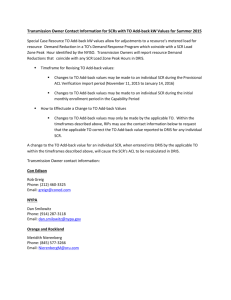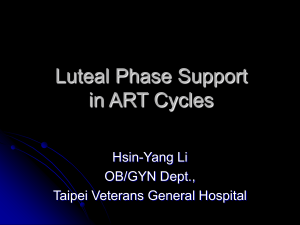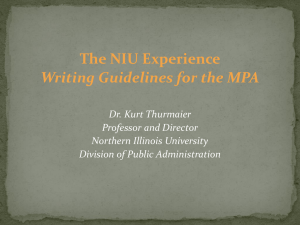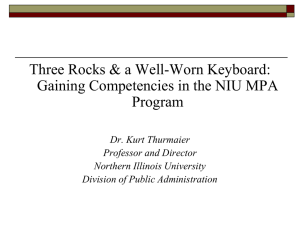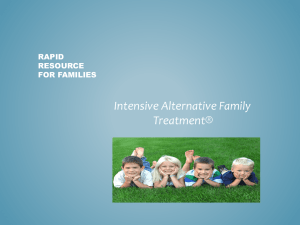Medical Management of Symptomatic Endometriosis
advertisement
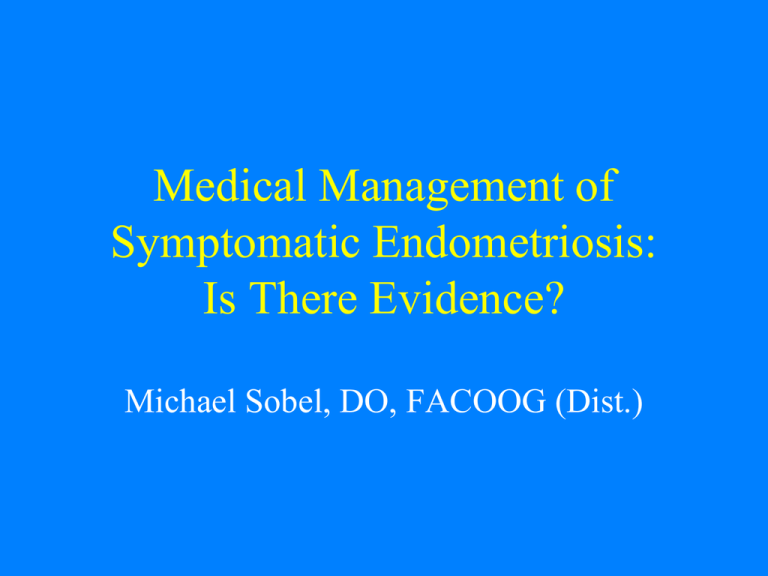
Medical Management of Symptomatic Endometriosis: Is There Evidence? Michael Sobel, DO, FACOOG (Dist.) Faculty Disclosure Dr. Michael Sobel has no financial interest about products or services of a commercial interest that could represent a conflict concerning the content of this presentation Learning Objectives • Describe various pathophysiologic bases of medical therapy in the management of symptomatic pelvic endometriosis • Cite the randomized control trials that have compared different medical therapies for pain control • Apply the knowledge derived from basic science data and clinical trials to treatment paradigms for endometriosis Pathophysiologic Bases of Treatment • Retrograde menstruation/transplantation – Peritoneal angiogenesis, proliferation, invasion, inflammation, innervation • Coelomic metaplasia • Genetic predisposition – Multifactorial/Polygenic trait • Immunomodulation • Environmental triggers – PCBs, TCDD, Cadmium • Congenital anomalies – Obstructive Therapeutic Basis of Treatment Related to Pathogenesis Retrograde transplantation STOP SEEDING OF MENSTRUAL DEBRIS COCs, Progestins, LNG-IUD, GnRH-a, Androgens, Aromatase Inhibitors, Anti-estrogens Therapeutic Basis of Treatment Related to Pathophysiology Endometriosis is: Estrogen Dependent Progesterone Resistant Angiogenic Inflammatory Evidence That Endometriosis is Estrogen Dependent • Unusual before menarche (has been reported in thelarche) • Prolongd E2 exposure – early menarche – nulliparity (more menses) – xenoestrogen exposure (Messmer, 2004) • Animal models – trophic effects of E2 in mice implants (Osteen, 2007) Endometriosis and Progesterone • Lesions are P4 resistant • Progestins are commonly used (counterintuitive) • Because they – – – – have anti-angiogenic effects are immunomodulatory are anti-inflammatory oppose E2 action Evidence of Inflammation • Observe high levels of inflammatory cytokines (IL-8, IL-1, TNF-) in peritoneal fluid (PF) in women with ‘osis • PF activated macrophages secrete inflammatory cytokines • PF activated macrophages cannot phagocytose endometrial cells • Levels of ENDO I (haptoglobin) increased • In systemic circulation, higher levels of TNF- and IL-8 Endometriotic Lesions/PF • Lesions are invasive – Matrix metalloproteinase -1, 2, 3, 7, 11 – Plasminogen activator – Cathepsin D • Lesions are angiogenic – VEGF (most studied) Local E2 Production in Endometriosis Aromatase androstenedione E1 E2 growth factors, PGFE2, PGF2a adhesions, angiogenesis, proliferation (so endogenous lesions locally produce E2) Treatment of Endometriosis • Surgical (first -line) • Medical • Primary surgical followed by post-op medical RCT, Double-Blind, Placebo-Controlled Author, Yr Procedure Follow-up % improved Sutton 1994 Ablation/ LUNA N=32 N=31 Diagnostic 6 mo 63% 6 mo 22% Abbot,2004 Excision N=20 N=19 Diagnostic 6 mo 80% 6 mo 32% Endometriomas • Cochrane data review • 2 randomized trials comparing excision v. drainage/ablation by L-scope • Excision: – Lower recurrence rate – Less pain, less repeat surgery – Higher spontaneous pregnancy rates Endometrioma Resection and Ovarian Reserve • 93 patients with resection of ‘oma followed by an IVF cycle • No follicular growth in 12 ovaries operated • Frequency of severe ovarian damage: 13% had no follicles at time of hCG trigger • BE CONSERVATIVE AND PRESERVE OVARIAN BLOOD FLOW Treatment of Endometriosis • Surgical • Medical (first-line) • Surgical followed by post-op medical Currently Available Medical Options for Endometriosis • GOAL: minimize proliferation/reduce pain • Inhibit inflammation (NSAIDs) • Minimize menstrual volume/frequency (OCPs, progestogens/ L-IUS, anti-progestogens RU486, gestrinone) • Oppose E2 action (OCPs, progestogens/L-IUS, anti-progestogens) Current Available Medical Options • Create a hyperandrogenic state (equivalent to progestins action on the endometrium and inhibition of gonadotropin secretion: Danazol) • Aromatase inhibitors (inhibits E2 synthesis) Pelvic Pain Results With Cyclic OCPs Citation Tx Relief (%) Sample Kistner, 1956 Enovid 79 110 Riva, 1961 Enovid 90 83 Riva, 1962 Enovid 69 132 Kourides, 1969 EE/Norgestrel 84 19 Vercellini, 1993 EE/Desogstrl 88 24 Harada, 2008 EE/NET P<.0001 51 Continuous OCPs • • • • • N = 50 monitored prospectively No control Rx: EE 0.02mg / Desogestrel 0.15mg Mode: continuously for 2 years Conclusion: Pain relief in 96% » Vercellini, Fertil Steril, 2003; 80(3), 560-563 Oral Progestin Tx Time (mo) Relief (%) Author Rx, mg N Luciano, 1988 MPA, 50 21 4 88 Schlaff,1990 Mgstrl, 40 9 4 86 Vercellini, 2002 CyprAc, 2.5 45 12 33 Delale NET Ac, 5-70 52 >6 94 Vercellini, 2009 NET Ac, 2.5 45 12 80 Herada, 2009 Dienogest 2 128 6 P<.05 Depot MPA v GnRHa • Prospective, double blind, multi-center • N=136 (depot MPA 104mg) • N=138 (depot GnRHa 11.25mg, q 3 mo x 2 with 12 mo follow-up) • Drop-outs (%): MPA, 35 ; GnRHa, 26 – Schlaff, Fertil Steril 2006, 85;314-325 Depot MPA v GnRHa: Results • Pain, dysmenorrhea, dyspareunia: equal improvement • Greater improvement in duration: agonist • MPA: less vasomotor instability, more BTB • Bone density loss: – Spine : MPA (1.1%) , GnRHa (3.95%) – Hip : MPA (0.3%) , GnRHa (1.65%) Schlaff, 2006 Levonorgestrol IUS • • • • Prospective, randomized trial (N = 82) N = 39 (LNG-IUS) N = 43 (GnRHa) Results – Equivalent pain reduction both groups – No differences in QOL improvement between groups – More bleeding events in IUS group Petta, Hum Reprod 2005, 20; 1993-1998 Danazol Therapy Author AFS Pain Score% (%) 65 88 10 Time (mo) 6 Dose (mg) 800 Shaw 103 6 600 52 68 Kennedy 24 6 600 20 87 Rock 107 6 400-800 33 75 Henzl 80 6 800 43 78 Dmowski N GnRH Agonist Therapy Duration Score Pain Author Agonist N Diugi LeuAc 52 6 - 89 Surrey LeuAc 10 6 55 72 Henzl 77 6 43 73 16 6 78 63 Naf Steingld Histrln Rock Gosrln 208 6 56 75 Shaw Gosrln 204 6 60 74 Dmwski Busrln 22 6 67 69 Wright LeuAc 9 3 20 - Medical Therapies Under Investigation • • • • • • • • • Oral GnRH antagonists Aromatase Inhibitors P4 receptor modulators TNF- blockers Angiogenesis inhibitors Metalloproteinase inhibition Estrogen receptor inhibition PPAR- agonists Chinese herbs (nociceptor neurons) • Nutrition: omega-3, green tea Letrozole + Norethisterone Acetate • Study design: open-label, nonrandomized 6 month trial • N = 82 • N = 41, Letrazole 2.5mg/NETAc 2.5mg/Calcium/Vit D, 1000mg/800IU daily • N = 41, NETAc 2.5mg daily » Ferrero, Hum Reprod 2009, 24; 3022-3041 Letrazole + NETAc: Results • Significant decrease in pain by 3 months in both groups (P<.001) • At 3 and 6 months, pain (P<.001) and dyspareunia (P=.002) less in letrazole group • Adverse events more frequent with letrazole (P=.02): vasomotor sx, mood, myalgias, BTB Ferrero Hum Reprod 2009 Management of Endometriosis • Surgical • Medical • Post-op Medical OCPs To Prevent Endometrioma Recurrence • • • • N = 239 / age 20 to 40 / nulliparous / prospective RCT Endometrioma (s) pre-op ± 4cm All underwent L-scope for excision/cystectomy Groups – A; Nonusers (n = 79) – B: Cyclic users (n = 81) : EE (20)/Gestodone (0.075) – C: Continuous (n = 79) • Follow-up sono q6 mo for 24 mo • Recurrence defined as ‘oma ± 1.5cm Seracchioli R, et al Fertil Steril 2010;93:52-56 OCPs To Prevent Endometrioma Recurrence: Results • • • • • Study completion: n = 217 of 239 starting By group completed: A(n=69), B(n=75), C(n=73) Total of 37 recurrences: A(20), B(11), C(6) P significant between users and non users P not significant between cyclic and continuous • Seracchioli, et al. Fertil Steril 2010;93:52-56 Investigated Add-Back Therapy Progestin alone MPA NETAc E+P P + Bisphos PTH 6 months X X X X X 12 months X X X Estrogen Threshold Hypothesis • Can we get the E2 level at a minimum to treat disease and minimize side effects? • E2 effects on different tissue are doserelated • Assumption: all women have the same threshold – Barbieri, Am J Obstet Gynecol 1992;166, 740-745 Estrogen Threshold Response Therapeutic Window 100 % max respnse 0 Bone turnover Bone loss Substantial Stimulation of endometriosis Bone loss minimal growth atrophy 30 50 Estradiol Concentration (pg/mL) 70 Barbieri, Am J Obstet Gynecol 1992 GnRHa and OCPs as Add-Back • • • • • • • Prospective, randomized 6 month trial GnRHa OCP (EE 30/desogestrol 0.15) N = 27 (14 controls, 13 add-back) dysmenorrhea, pain ∆ AFS score in add-back group (P = 0.02) dyspareunia: control > OCP add-back vasomotor instability: OCP > control Freundl, Gynecol Obstet Invest 1998, 45 (Suppl 1), 22 E/P Add-Back vs GnRHa Alone: Randomized Trials Kilhoma, 1995, n=88 Gregoriou, 1997, n=40 Moghissi, 1998 n=345 Franke, 2000 n=41 Irahara, 2001 n=21 Goserelin TDE/MPA 6 months Leuprolide E2/NETA 6 months Goserelin CEE/MPA 6 months Goserelin EE/NETA 6 months Leoprolide CEE/MPA 6 months E/P Add-Back vs GnRHa Alone Kilhoma Gregoriou Moghissi Franke Irahara Sx both groups Sx both groups Sx both groups Not evaluated Not evaluated vasomotor BMD: Not with add-back evaluated vasomotor BMD: -4% vs with add-back -0.9% BMD: -4% vs vasomotor with add-back -1.9% Kupperman -5% vs -0.2% index w/ adbk Kupperman -6.3% vs index w/ adbk 0.8% Estrogen Threshold Hypothesis: Is There an E2 level “just right” • • • • Low enough to prevent disease stimulation High enough to inhibit hot flashes High enough to inhibit bone loss Why not just use progestin alone as addback? How to reduce concerns of estrogen in add-back formulation Just use a progestin Progestins as Add-Back • MPA: reduces vasomotor instability, not effective at suppressing disease or symptoms (20 - 30mg/d x 6 mo)1 • MPA: effective at 100mg2 • Net: effective at up to 2.4mg/d x 6 mo, but BMD3 • NetAc: effective at 5mg/d x 12 months4 1. Cedars Obstet Gynecol 1990, 75; 641-645 2. Surrey Fertil Steril 1990, 53; 620-626 3. Bergovist Gynecol Endocrinol 1997, 11;187-194 4. Hornstein Obstet Gynecol 1998, 91;15-24 Norethindrone Acetate as Add-Back: Mechanisms of Action • NetAc undergoes hepatic metabolism to EE • 2-pronged effect: – EE provides bone effect and reduces vasomotor instability – Net has direct effect on endometrium • Result: Synergy with GnRHa Long-Term GnRHa and Progestin Add-Back for Endometriosis: One Year Clinical Trial • RCT, prospective, double-blind, n = 201 • FOUR treatment groups: – – – – GnRHa + daily placebo tabs GnRHa + daily NetAc (5mg) GnRHa + daily NetAc (5mg) + CEE (0.625mg) GnRHa + daily NetAc (5mg) + CEE (1.25mg) • Horstein, Surrey, Weisberg, Casino Obstet Gynecol 1998,91:16-24 Long Term GnRHa: Results • Pelvic Pain: Improved in all groups (with higher estrogen doses, less pain improvement and more dropout) • Vasomotor: virtually eliminated in all 3 add-back groups • BMD: no significant bone loss in all 3 add-back groups Mean % Change From Baseline in BMD: Prolonged GnRHa and Progestin Add: 1 Year Trial 2 1 0 -1 -2 -3 -4 -5 -6 -7 -8 GnRH GnRH/NetAc Gn/NetAc/CEE Gn/Net/CEE P<.001 compared with GnRHa alone Long-Term Follow-up For Prolonged GnRH • Endpoints: Patients in the 1-year study were followed for 12 months after completion for symptom recurrence and return to normal BMD • Pain: suppressed pain up to 12 months posttherapy • GnRHa alone: needs 18 months for BMD to return to normal » Surrey Obstet Gynecol 2002, 99;709-719 Can You Defer Add-Back? • • • • • • Randomized 6 month trial Group A: GnRHa + (medrogestone 10mg) x 6 mo Group B: GnRHa alone, then add-back mo 4 - 6 Group C: GnRHa alone x 6 months Equal disease improvement in all groups Lowest BMD loss and vasomotor sx with immediate add-back • Greatest rate of bone loss: during first 3 months » Kessel Br J Obstet Gynecol 1996, 103;15-17 Add-Back Dosing and GnRHa Compliance • Industry-based study • Retrospective analysis of > 1200 patients starting GnRHa for ‘osis add-back • 32% used add-back (most common was Net) • Compliance higher with add-back (5.8 3 mo vs 4.3 2.6 mo, P<.01) • Fuldeore Curr Med Res Opin 2010, 26(3),729-736 Symptomatic Endometriosis: Standard 6 Month Treatment • NetAc up 5mg daily, increasing dosing to eliminate vasomotor instability • CEE up to 0.625mg + MPA 5mg daily* • OCPs ARE NOT EFFECTIVE ADD-BACK • Unless high-risk, BMD not necessary • Please, do not defer add-back *this or lower doses of NetAc considered off-label use Down-Regulation for Endometriosis: Extended or Retreatment • Norethindrone acetate daily 5mg • Add Estradiol if vasomotor instability persists Take Home Points • As long as the patient has endogenous 17estradiol production, surgery is not curative, only cytoreductive • Medical therapy, either primary or post-op, is adjunctive and effective in outcome improvement for ANY disease stage • Always consider add-back when GnRHa is used • Treatment of the Adolescent
